全文HTML
--> --> -->石墨烯作为典型的二维材料, 在室温下具有超高的载流子迁移率(105 cm2/(V·S))、超大的比表面积、优异的透光性(单层光吸收仅有2.3%)以及良好的导热、导电性, 本应为一种非常理想的光催化剂材料[13]. 然而, 石墨烯为零带隙结构[14], 使得其开关比较低, 无法作为光催化剂在应用于光电化学领域. 为了打破这一局限性, 可引入其他二维材料构成范德瓦耳斯异质结, 使其成为高效的光催化剂材料. 二硫化铼(ReS2), 作为过渡金属硫化物家族的一员, 因其独特的1T相结构, 展现出有别于传统过渡金属硫化物的优异性质[15-17]: 1) ReS2始终为直接带隙半导体, 电子跃迁无需声子辅助, 因此相较于其他二维材料具有更强的光电化学性能; 2) 研究表明, 由于ReS2具有类单层特性, 当光照射到ReS2表面时, 其内部的自由电子可以被紧束缚激子捕获, 从而形成大量的带电激子(trion, 包含两个电子和一个空穴)[17]. 这些带电激子均可参与到光电化学反应之中, 大幅提升其光电化学响应. 更有趣的是, 当ReS2与另一种二维材料形成范德瓦耳斯异质结后, 由于界面场的存在, 光生载流子在两种材料间转移加速, 将促进带电激子的产生并使载流子动力学特性进一步增强.
基于此, 本文针对上述问题采用液相剥离法结合电泳沉积法制备具有不同堆垛结构的ReS2/石墨烯异质结薄膜: ReS2-Gra异质结(ReS2位于上方, 石墨烯位于下方)、Gra-ReS2异质结(石墨烯位于上方, ReS2位于下方). 随后, 对制备得到的不同堆垛结构的范德瓦耳斯异质结光电极进行了I-T, I-V曲线等光电化学测试, 结果显示: 1) 相较于纯ReS2、纯石墨烯以及其他几种常见二维材料, ReS2/石墨烯异质结的光电流得到了显著提升; 2) Gra-ReS2异质结光电化学特性优于ReS2-Gra异质结, 且前者异质结与纯ReS2光电极最大光电流差近乎是后者的3倍之多. 本工作对于其他范德瓦耳斯异质结的制备具有参考价值, 同时也为光电探测器以及其他太阳能转换器件的研究铺平了道路.
2.1.二硫化铼、石墨烯纳米片制备
ReS2和石墨烯纳米片的制备过程如图1所示, 具体步骤如下. 1) 粉末混合: 将200 mg ReS2/石墨烯粉末(均购自Alpha公司)分别与600 mL N-甲基吡咯烷酮(N-methylpyrrolidone, NMP)溶液混合得到混合溶液. 2) 超声剥离: 将超声剥离机(Qsonica Q700)的超声功率设置为550 W, 使用水浴控制溶液温度, 对悬浮液处理60 min. 3) 离心处理: 将悬浮液移入离心管后置于高速离心机中, 设置离心机转速为5000 r/min, 离心时间为10 min. 4) 取上清液: 取离心管中75%的上清液, 即可获得含ReS2/石墨烯纳米片的溶液.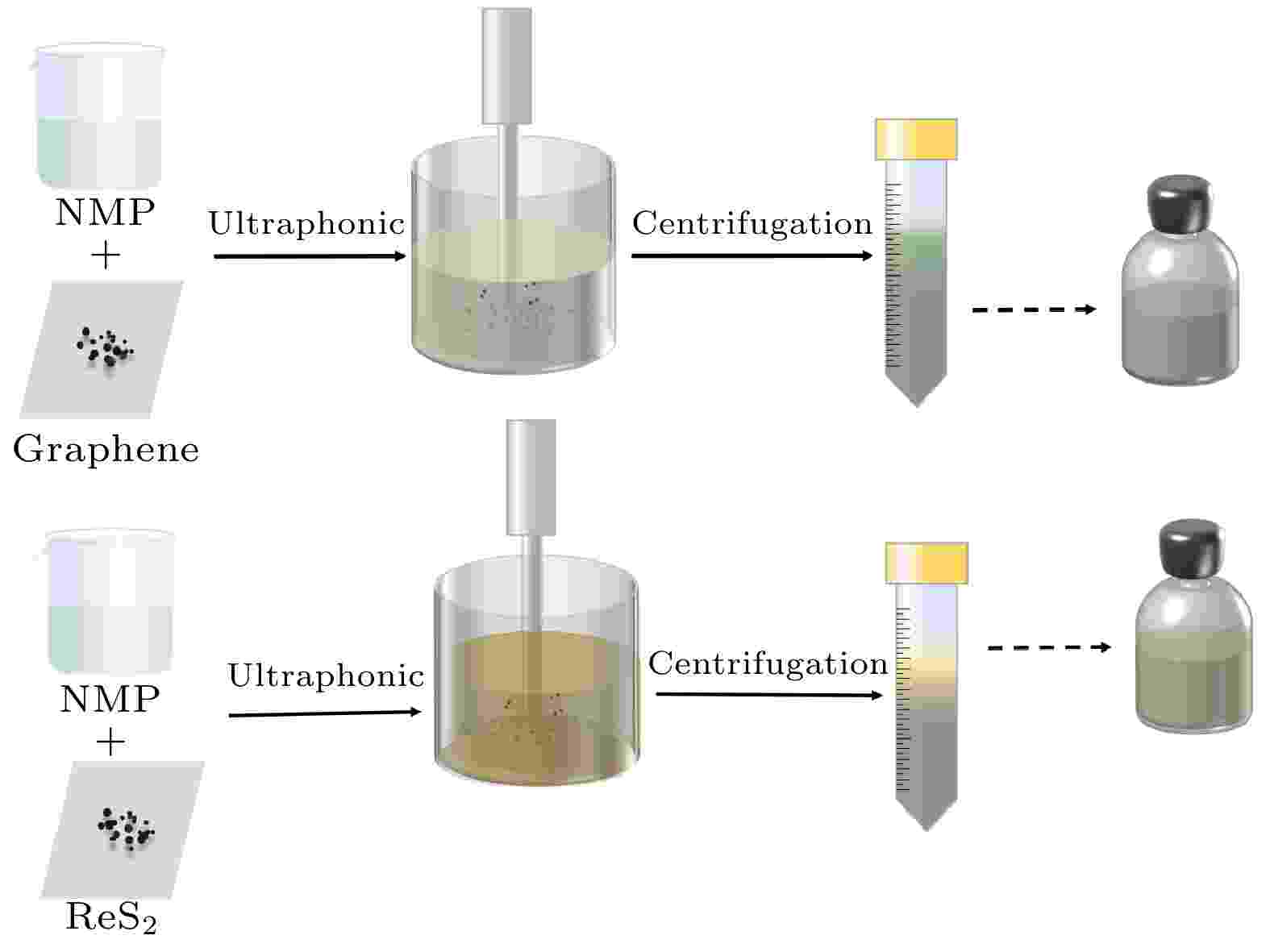 图 1 ReS2和Graphene纳米片制备过程示意图
图 1 ReS2和Graphene纳米片制备过程示意图Figure1. Preparation process of ReS2 and Graphene nanosheets
2
2.2.不同堆垛结构二硫化铼/石墨烯异质结薄膜制备
电泳沉积法相对真空抽滤法转移具有操作简单、时间短、效率高、安全指数高、成本低且易于控制薄膜厚度等优点[14]. 本文采用电泳沉积法制备四种薄膜: ReS2薄膜、石墨烯薄膜、Gra-ReS2异质结薄膜(薄膜结构: 石墨烯在上, ReS2在下)、ReS2-Gra异质结薄膜(薄膜结构: 石墨烯在下, ReS2在上). 在转移ReS2薄膜时, 两电极分别夹住目标基底FTO导电玻璃和Ti片, 放入到含ReS2纳米片的上清液中, 两电极需相距2 cm且保持平行; 直流电源正极接目标基底, 负极接Ti片; 直流电源的电压设置为100 V, 沉积1 min后即可得到ReS2薄膜. 随后将薄膜放置于真空干燥箱中, 60 ℃烘干20 min; 最后在氩气环境下400 ℃煺火20 min以增加材料致密性, 即可得到用于光电化学实验的ReS2薄膜. 转移石墨烯薄膜的操作步骤同上.Gra-ReS2异质结薄膜的制备过程示意图如图2所示. 将电泳沉积1 min后得到的含有ReS2薄膜的基底接正极, Ti片接负极, 两电极放入含有石墨烯纳米片的上清液中继续沉积1 min, 随后重复上述步骤得到可用于光电实验的Gra-ReS2异质结构薄膜. 制备ReS2-Gra异质结构薄膜, 需先沉积石墨烯纳米片, 其次沉积ReS2纳米片.
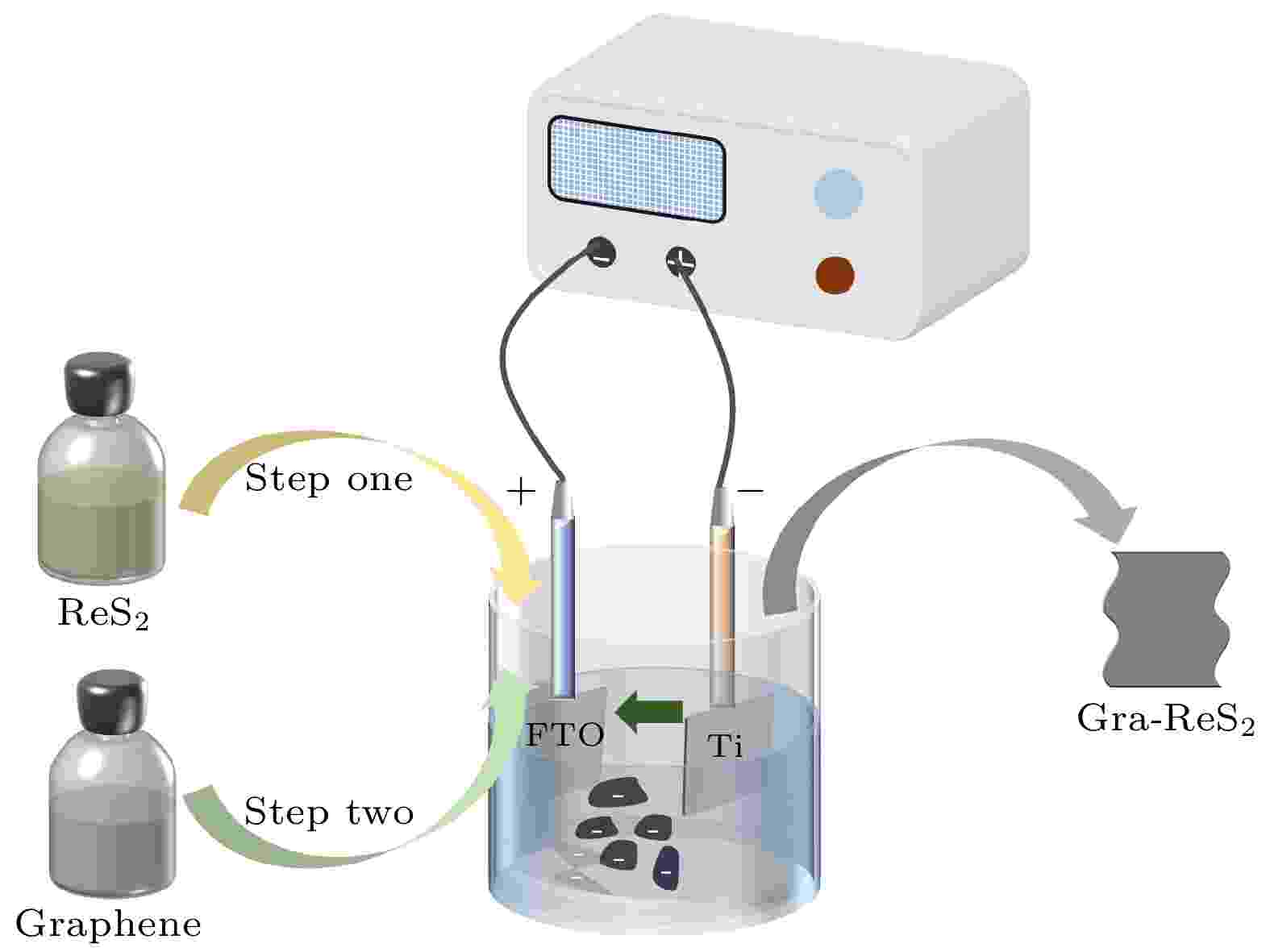 图 2 Gra-ReS2异质结薄膜的制备过程示意图
图 2 Gra-ReS2异质结薄膜的制备过程示意图Figure2. Preparation process of Gra-ReS2 heterojunction.
3.1.异质结薄膜表征
为了确定异质结已成功制备, 对所制备的材料进行了拉曼(Raman)光谱的表征, 结果如图3所示. 在1000—3000 cm–1区间可观察石墨烯的特征峰: D峰、G峰、2D峰分别位于1348, 1570和2691 cm–1处[18]. 在100—400 cm–1区间可观察ReS2由S原子平面内振动引起的Ag峰分别位于132和140 cm–1; 由Re原子平面内振动引起的Eg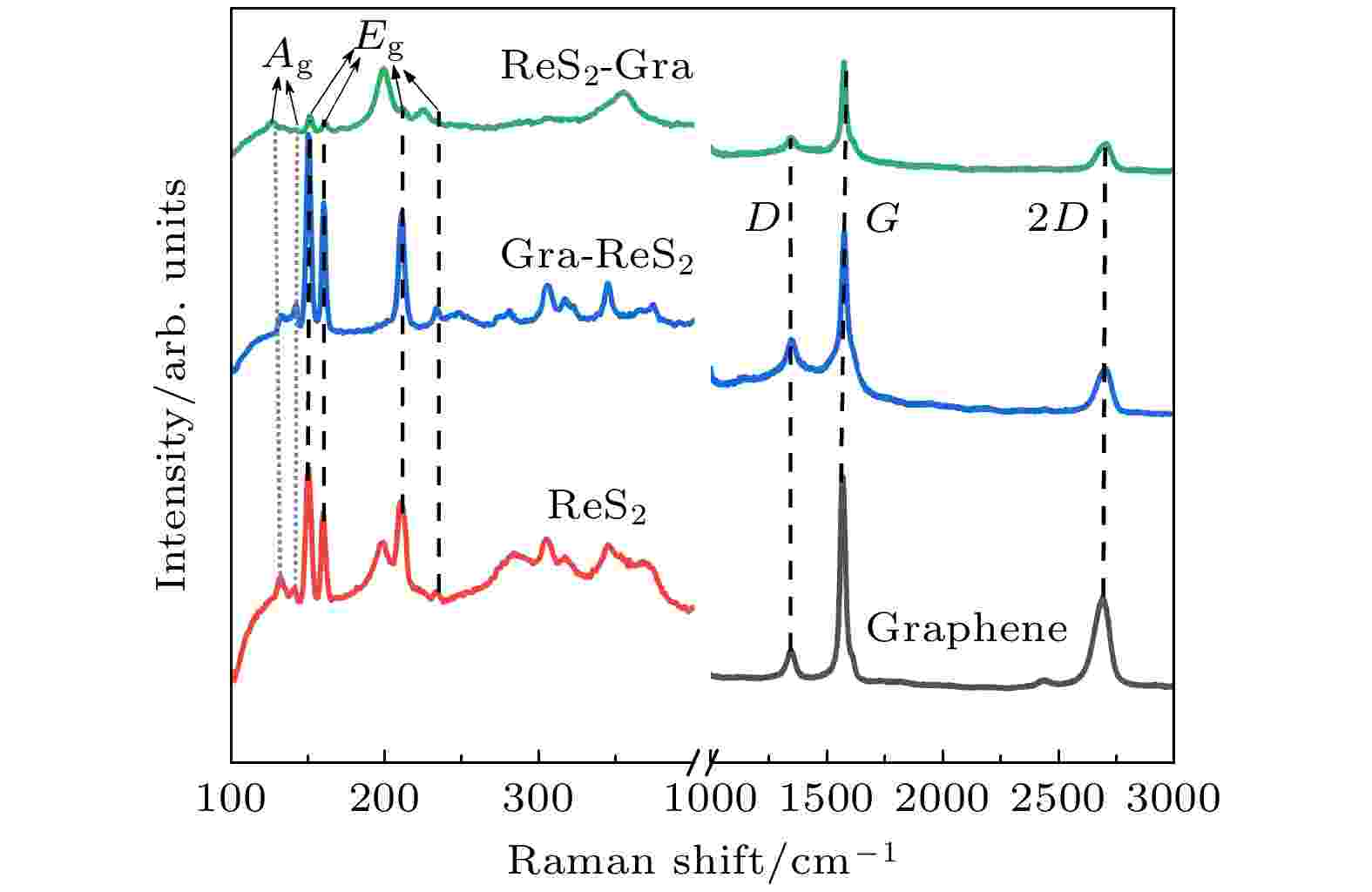 图 3 ReS2、石墨烯、Gra-ReS2、ReS2-Gra异质结拉曼光谱图
图 3 ReS2、石墨烯、Gra-ReS2、ReS2-Gra异质结拉曼光谱图Figure3. Raman spectra of ReS2, graphene, Gra-ReS2 heterojunction and ReS2-Gra heterojunction.
2
3.2.光电性能分析
本实验采用具有三电极系统的光电化学反应池作为反应器表征样品的光电性能, 光源为500 mW·cm–2氙灯, 电解液为250 mL 1 mol/L的NaSO4溶液, 工作电极为制备的光电极薄膜, 辅助电极为铂丝, 起到导通电路的作用, 参比电极为饱和甘汞电极(saturated calomel electrode, SCE)用以确定工作电极的电势. 将石墨烯、ReS2、ReS2-Gra异质结、Gra-ReS2异质结薄膜分别作为光电极, 在相同条件下进行线性伏安特性扫描(相对于SCE的电极电势, 外加偏压–0.9—0 V, 扫描间隔0.001 V)以观察其光电特性, 结果如图4所示.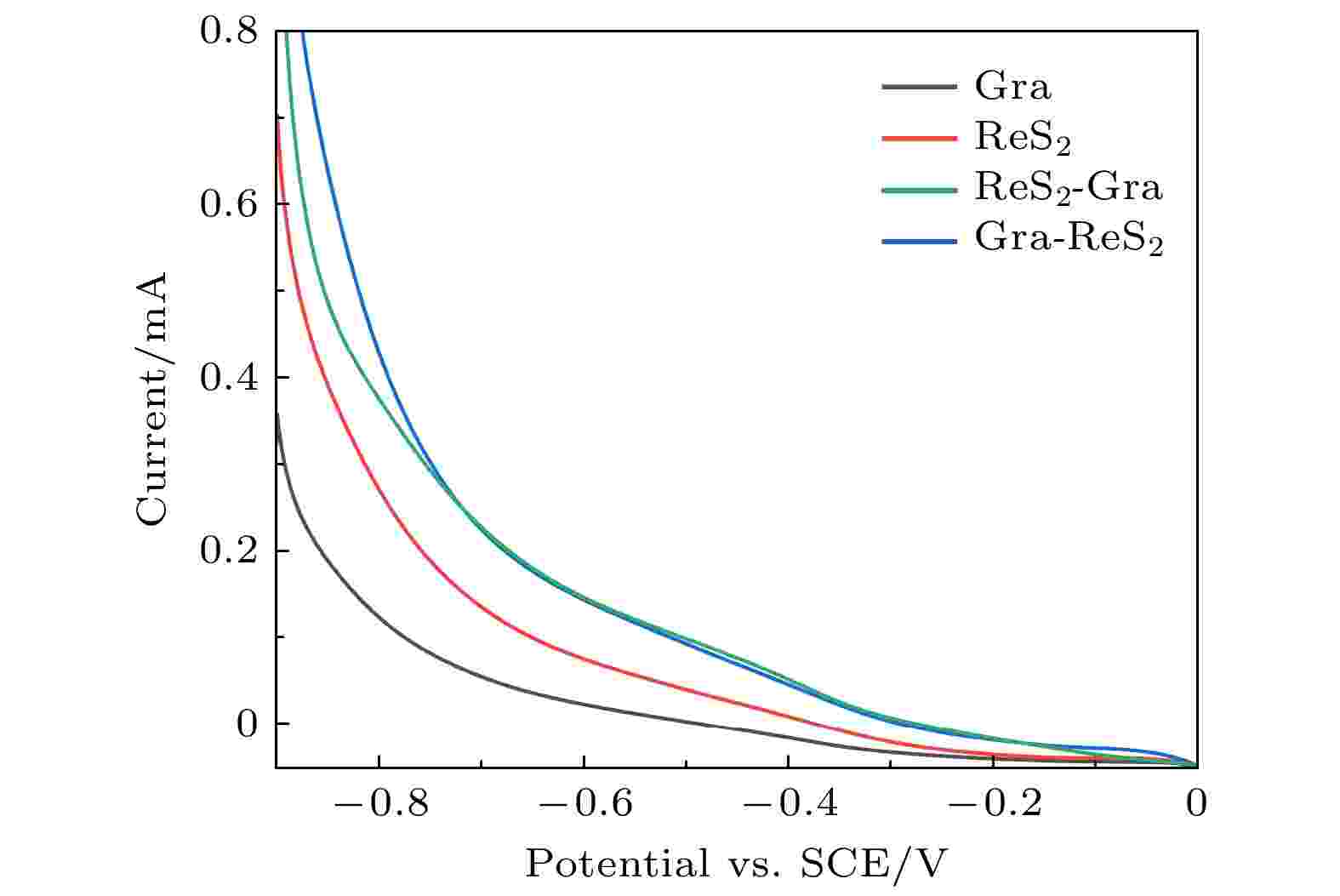 图 4 光电极的I-V曲线
图 4 光电极的I-V曲线Figure4. The I-V curves of photoelectric electrode.
1) 在外加偏压的作用下, 两种堆垛结构的异质结均使材料的光电响应得到不同程度的增强; 2) 所有光电极的光电响应均随着外加负偏压值的增大而增大, 当外加偏压从0 V增加到–0.7 V时, 两种垂直结构光电极的I-V曲线几乎重合; 而当外加偏压从–0.7 V增加到–0.9 V时, Gra-ReS2异质结光电极的光电响应显著大于ReS2-Gra异质结. 说明在Gra-ReS2异质结的作用下抑制了电子与空穴的复合, 促使光生载流子迅速分离的能力强于ReS2-Gra异质结, 因此提高了光电响应效率.
图5(a)为FTO基底、石墨烯、ReS2、ReS2-Gra异质结、Gra-ReS2异质结光电极在外加偏压–0.9 V时控制无光和光照各5 s交替进行, 得到的I-T曲线图. 由图5(a)可知, 由于石墨烯的零带隙特性, 使其开关比较低, 从而光电流要远小于其他光电极材料. 形成异质结后, 光电流得到明显增加, 并且Gra-ReS2此种堆垛结构的异质结光电极增幅更大. 为了更直观地显示各光电极达到稳定后的光电流大小, 将结果绘制为柱状图, 如图5(b)所示. 石墨烯、ReS2、ReS2-Gra异质结、Gra-ReS2异质结光电极的光电流分别是: 0.37, 1.16, 1.60和2.48 μA. 与ReS2相比, Gra-ReS2异质结、ReS2-Gra异质结的光电流分别增大了1.31和0.44 μA, 前者近乎是后者的3倍.
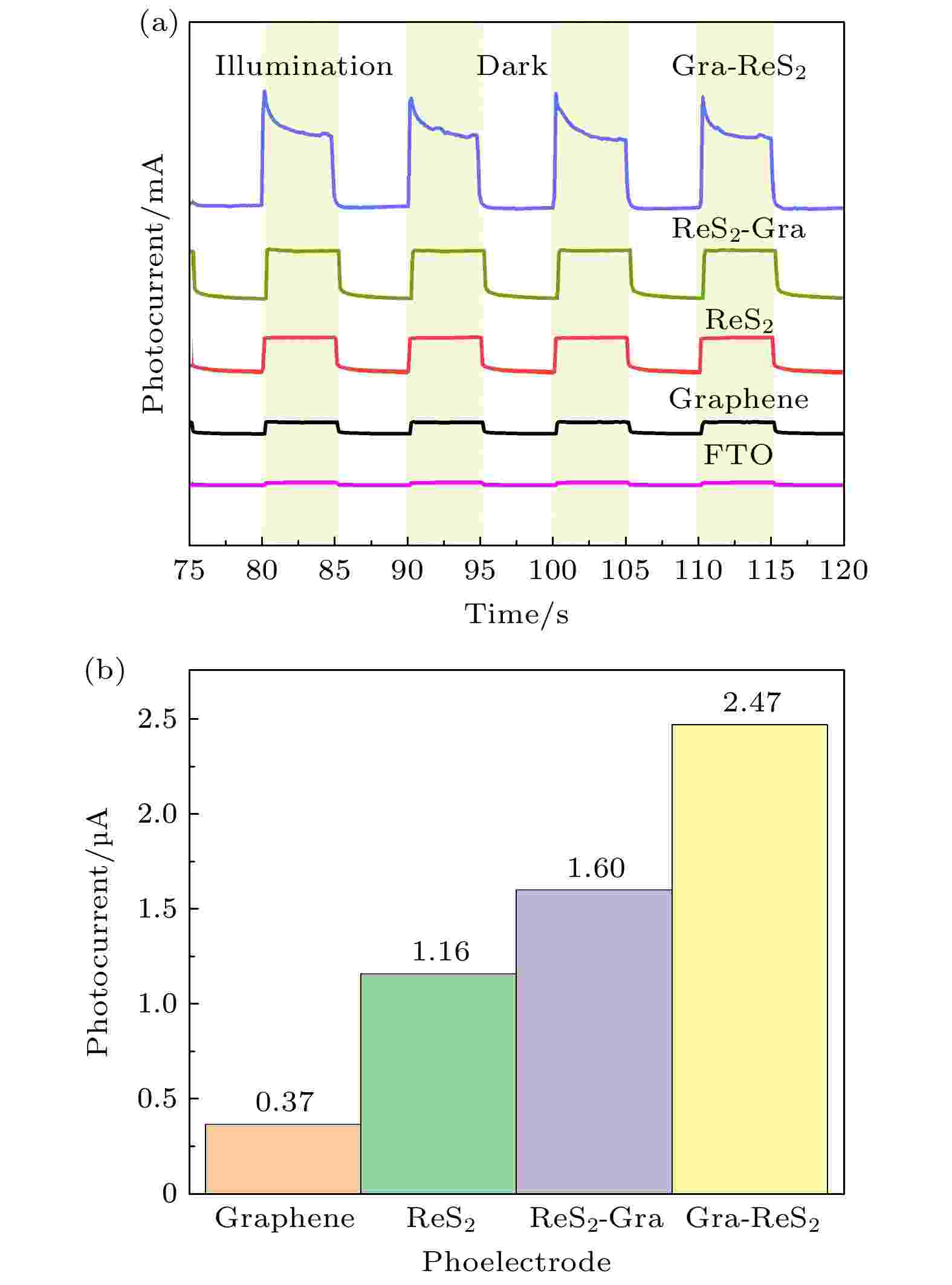 图 5 (a) 光电极的I-T曲线; (b) 各光电极的最大光电流柱状图
图 5 (a) 光电极的I-T曲线; (b) 各光电极的最大光电流柱状图Figure5. (a) The I-T curves of photoelectric electrode; (b) maximum photocurrent histogram of photoelectric electrode.
图6为Gra-ReS2与ReS2异质结光电极的光电流响应时间. 两种光电极的光电流上升沿响应时间分别为1.5 s和0.3 s, 两种光电极的光电流下降沿响应时间分别为0.8 s和1.3 s. 说明这两种异质结构均可产生响应迅速的光电流. 在此光电化学实验中, 光电流的响应时间除了与耗尽层附近光生载流子的扩散和飘逸有关外, 还和整个电路的电容与电感相关. 当石墨烯位于上方时, 光生载流子的漂移时间和电路的时间常数都在增加, 这便导致了响应时间的增加.
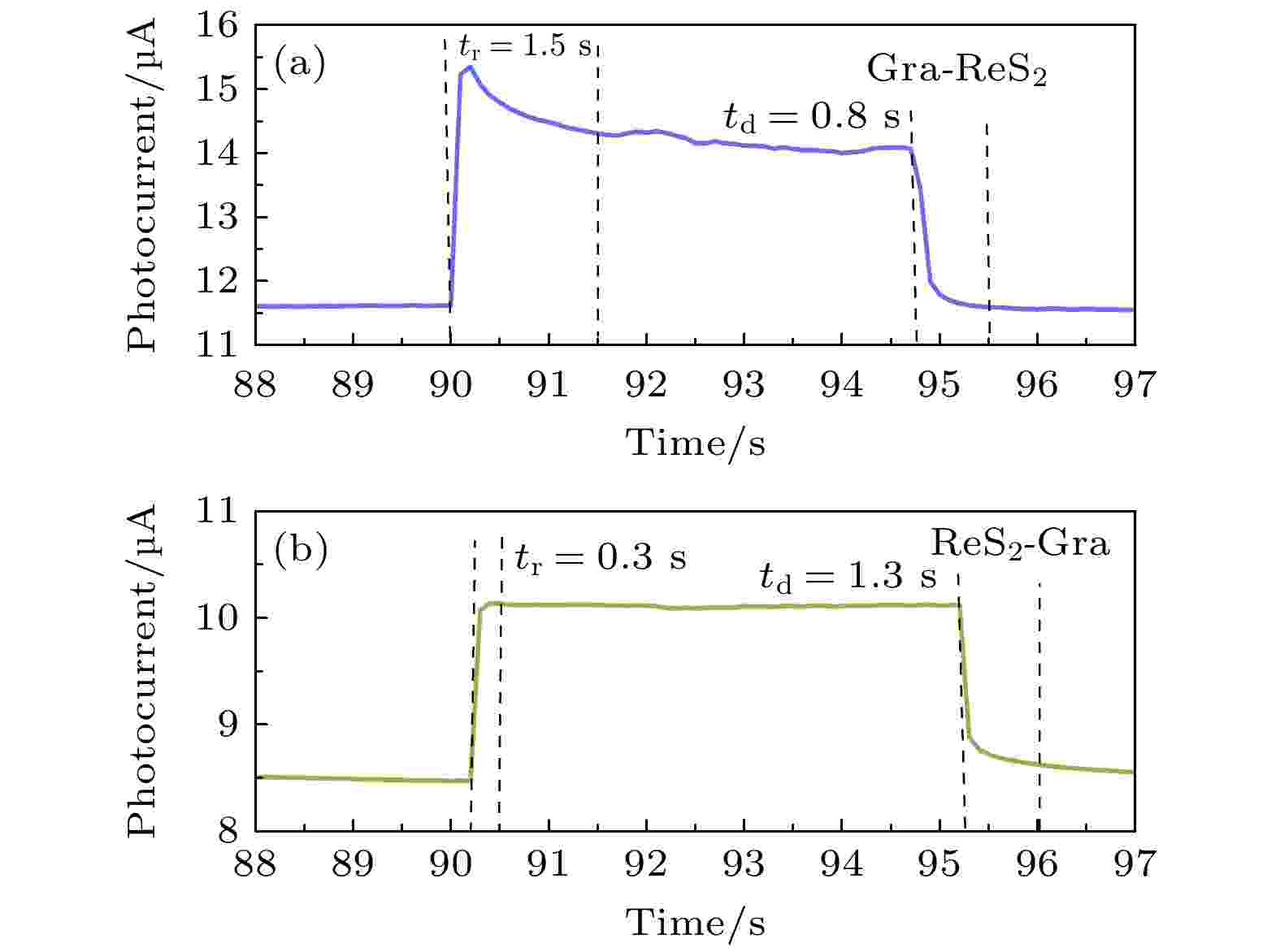 图 6 (a) Gra-ReS2和(b) ReS2-Gra光电极的光电流上升及衰减时间响应
图 6 (a) Gra-ReS2和(b) ReS2-Gra光电极的光电流上升及衰减时间响应Figure6. Rising and decay response time of photocurrents from (a) Gra-ReS2 photoelectrode and (b) ReS2-Gra photoelectrode.
2
3.3.讨论与分析
表1为光电极与其他二维材料光电极产生的光电流大小对比情况[9,10,22,23]. 首先, 发现ReS2产生的光电流要大于WS2, MoS2, Bi2S3以及石墨烯等其他常见的二维材料. 这是因为ReS2具有类单层特性, 当光照射到ReS2表面时, 其内部的自由电子可以被紧束缚激子捕获从而形成大量的带电激子(包含两个电子和一个空穴)[17]. 这些带电激子中的双电子都可以参与到后续的光电化学反应之中, 从而可以获得更大的光电流. 同时, ReS2边缘含有丰富的活性点位, 暴露出大量不饱和硫位点, 同样可以增加其光电化学特性[17].| 2D materials | Photocurrent/μA |
| Graphene | 0.37 |
| Bi2S3[22] | 0.60 |
| WS2[10] | 0.52 |
| MoS2[23] | 0.64 |
| ReS2 | 1.16 |
| MoS2-Graphene[9] | 0.81 |
| MoS2-WS2[10] | 1.48 |
| ReS2-Gra | 1.60 |
| Gra-ReS2 | 2.47 |
表1二维材料的瞬态光电流
Table1.Transient photocurrent of two-dimensional materials.
其次, ReS2与石墨烯形成异质结后, 相较于纯ReS2与石墨烯, 光电流显著增大. 基于本文的实验结果, 针对ReS2/Graphene异质结提出了一种电子-空穴对有效分离、提升复合时间的可能机制, 如图7所示. 在合适能量的光照射下, ReS2与石墨烯中的电子从价带激发至导带(图中①所示); 随后, ReS2导带上的部分电子会转移至石墨烯的导带, 而石墨烯价带处的部分空穴则会移动至ReS2的价带, 从而促进电子-空穴对的分离(图中②所示); 而电子-空穴对的复合可能发生在同种材料的导带和价带上(图中④所示), 也可以在异质结材料对侧的价带与导带上(图中③所示). 最近, 关于二维材料范德瓦耳斯异质结的载流子复合时间研究表明: 过程③的电子-空穴对的复合时间比过程④的复合时间高出3—4个数量级[24,25]. 因此, 此种异质结的构建可以大幅提升载流子的分离效率, 从而提升光电极的光电化学响应.
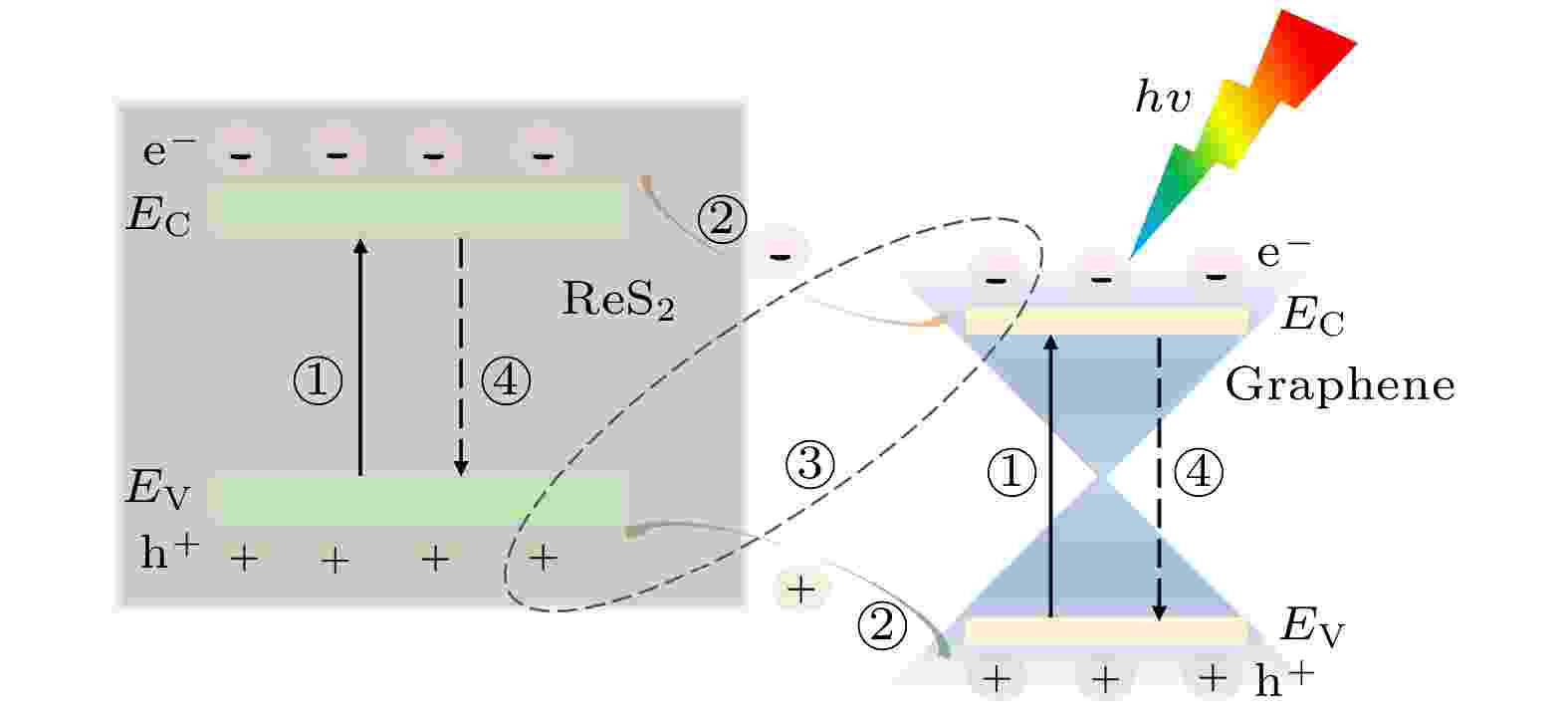 图 7 Gra-ReS2异质结的能带排列与电子迁移示意图(EV-价带, EC-导带)
图 7 Gra-ReS2异质结的能带排列与电子迁移示意图(EV-价带, EC-导带)Figure7. Gra-ReS2 heterojunction band alignment and electron mobility, where EC is energy of conduction band minimum, EV is energy of valence band maximum.
最后, 可以发现Gra-ReS2异质结的光电化学响应要优于ReS2-Gra异质结. 我们认为, 这是由两方面原因引起的: 1) 主要是因为石墨烯为零带隙结构, 具有更宽的光谱吸收范围, 当其位于上方时, 具有更高的光谱利用率及光生电子及光生空穴密度, 使其具有更强的光电化学响应; 2) 根据拉曼光谱表明(图3), Gra-ReS2异质结材料具有更好的致密性、结晶性和电子性能, 使其光电响应更为明显.
